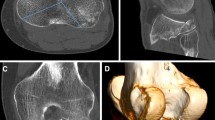Abstract
Purpose
A four-column classification system offers a different way of evaluating tibial plateau fractures. The aim of this study is to compare the intra-observer and inter-observer reliability between four-column and classic classifications.
Methods
This is a reliability study, which included patients presenting with tibial plateau fractures between January 2013 and September 2015 in a level-1 trauma centre. Four orthopaedic surgeons blindly classified each fracture according to four different classifications: AO, Schatzker, Duparc and four-column. Kappa, intra-observer and inter-observer concordance were calculated for the reliability analysis.
Results
Forty-nine patients were included. The mean age was 39 ± 14.2 years, with no gender predominance (men: 51%; women: 49%), and 67% of the fractures included at least one of the posterior columns. The intra-observer and inter-observer concordance were calculated for each classification: four-column (84%/79%), Schatzker (60%/71%), AO (50%/59%) and Duparc (48%/58%), with a statistically significant difference among them (p = 0.001/p = 0.003). Kappa coefficient for intr-aobserver and inter-observer evaluations: Schatzker 0.48/0.39, four-column 0.61/0.34, Duparc 0.37/0.23, and AO 0.34/0.11.
Conclusions
The proposed four-column classification showed the highest intra and inter-observer agreement. When taking into account the agreement that occurs by chance, Schatzker classification showed the highest inter-observer kappa, but again the four-column had the highest intra-observer kappa value. The proposed classification is a more inclusive classification for the posteromedial and posterolateral fractures. We suggest, therefore, that it be used in addition to one of the classic classifications in order to better understand the fracture pattern, as it allows more attention to be paid to the posterior columns, it improves the surgical planning and allows the surgical approach to be chosen more accurately.




Similar content being viewed by others
References
Gerard-Marchant P (1939) Fractures des plateaux tibiaux. Rev Chir Orthop 26:499–546
Duparc J, Ficat P (1960) Fractures Articulares de LExtremite Supérieure du Tibia. Rev Chir Orthop Reparatrice Appar Mot 46:398–486
Huten D, Duparc J, Cavagna R (1990) Fractures récentes des plateaux tibiaux de l’adulte. Éditions Techniques, Enc Med Chir, Appareil locomoteur, Paris
Gicquel T, Najihi N, Vendeuvre T, Teyssedou S, Gayet LE, Huten D (2013) Tibial plateau fractures: reproducibility of three classifications (Schatzker, AO, Duparc) and a revised Duparc classification. Orthop Traumatol Surg Res 99(7):805–816. doi:10.1016/j.otsr.2013.06.007
Schatzker J, McBrown R, Bruce D (1979) The tibial plateau fracture: the Toronto experience 1968-1975. Clin Orthop Relat Res 138:94–104
Muller ME, Nazarian S, Koch P (1987) Classification AO des fractures. Springer, Berlin
Luo CF, Sun H, Zhang B, Zeng BF (2010) Three column fixations for complex tibial plateau fractures. J Orthop Trauma 24(11):683–692. doi:10.1097/BOT.0b013e3181d436f3
Molenaars RJ, Mellema JJ, Doornberg JN, Kloen P (2015) Tibial plateau fracture characteristics: computed tomography mapping lateral, medial, and bicondylar fractures. J Bone Joint Surg Am 97(18):1512–1520. doi:10.2106/JBJS.N.00866
Postel M, Mazas F, de la Caffinière JY (1974) Posterior fracture-separation of the tibial plateaux. Rev Chir Orthop Reparatrice Appar Mot 60(2 Suppl):317–323
Martínez A, Cayón M (1999) Fracturas del platillo tibial postero medial. Rev Colomb Ortop Traumatol 13(1):37–41
Doornberg JN, Rademakers MV, van den Bekerom MP, Kerkhoffs GM, Ahn J, Steller EP, Kloen P (2011) Two-dimensional and three-dimensional computed tomography for the classification and characterisation of tibial plateau fractures. Injury 42(12):1416–1425. doi:10.1016/j.injury.2011.03.025
Yang G, Zhai Q, Zhu Y, Sun H, Putnis S, Luo C (2013) The incidence of posterior tibial plateau fracture: an investigation of 525 fractures by using a CT-based classification system. Arch Orthop Trauma Surg 133(7):929–934. doi:10.1007/s00402-013-1735-4
Chang SM, Hu SJ, Zhang YQ, Yao MW, Ma Z, Wang X, Dargel J, Eysel P (2014) A surgical protocol for bicondylar four-quadrant tibial plateau fractures. Int Orthop 38(12):2559–2564. doi:10.1007/s00264-014-2487-7
Sohn HS, Yoon YC, Cho JW, Cho WT, Oh CW, Oh JK (2015) Incidence and fracture morphology of posterolateral fragments in lateral and bicondylar tibial plateau fractures. J Orthop Trauma 29(2):91–97. doi:10.1097/BOT.0000000000000170
Hu YL, Ye FG, Ji AY, Qiao GX, Liu HF (2009) Three-dimensional computed tomography imaging increases the reliability of classification systems for tibial plateau fractures. Injury 40(12):1282–1285. doi:10.1016/j.injury.2009.02.015
Lowe JA, Tejwani N, Yoo B, Wolinsky P (2011) Surgical techniques for complex proximal tibial fractures. J Bone Joint Surg Am 93(16):1548–1559
Johnson EE, Timon S, Osuji C (2013) Surgical technique: Tscherne-Johnson extensile approach for tibial plateau fractures. Clin Orthop Relat Res 471(9):2760–2767. doi:10.1007/s11999-013-2962-2
Zeltser DW, Leopold SS (2013) Classifications in brief: Schatzker classification of tibial plateau fractures. Clin Orthop Relat Res 471(2):371–374. doi:10.1007/s11999-012-2451-z
Altman DG (1992) Practical statistics for medical research. Chapman & Hall, London
Tscherne H, Oestern HJ (1982) A new classification of soft-tissue damage in open and closed fractures. Unfallheilkunde 85(3):111–115
Acknowledgements
The authors thank Dr. Helen Reina for the copy editing of this manuscript, as well as Juan Esteban Restrepo, for his help with statistical calculations and analysis.
Author information
Authors and Affiliations
Corresponding author
Ethics declarations
Conflicts of interest
On behalf of all authors, the corresponding author states that there is no conflict of interest.
Funding
This research received no funding.
Informed consent
For this type of study formal consent is not required.
Ethical approval
All procedures performed in studies involving human participants were in accordance with the ethical standards of the institutional and/or national research committee and with the 1964 Helsinki declaration and its later amendments or comparable ethical standards.
The institutional review board approved this study.
Rights and permissions
About this article
Cite this article
Martínez-Rondanelli, A., Escobar-González, S.S., Henao-Alzate, A. et al. Reliability of a four-column classification for tibial plateau fractures. International Orthopaedics (SICOT) 41, 1881–1886 (2017). https://doi.org/10.1007/s00264-017-3543-x
Received:
Accepted:
Published:
Issue Date:
DOI: https://doi.org/10.1007/s00264-017-3543-x




